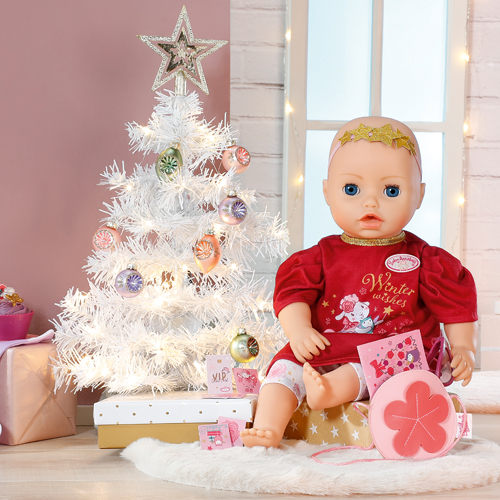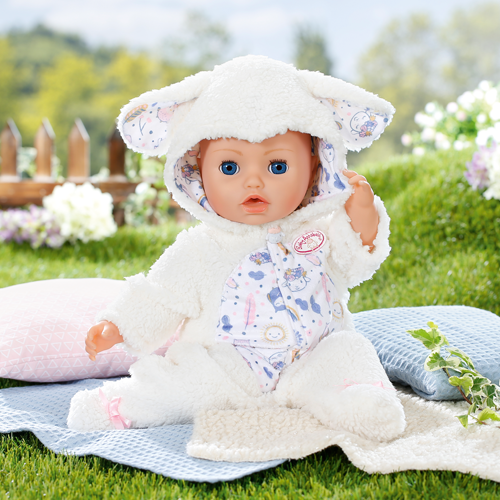
Parents often report significant challenges with bedtime for their young children. Typical issues may be represented by resistance to sleep, taking a long time for your child to achieve sleep at bedtime, routine callbacks, demands and requests for drinks, food and parental engagement; all may result in a frustrating and tiring end to what already has been a long day.
These quintessential bedtime battles impact how we complete the day with our children, sometimes leaving both parent and child dissatisfied and disconnected at a time in the day when contentment and connection are crucial to how your child experiences sleep.
We know that our children learn through play – and we can help instill positive emotions, feelings, and attitudes about bedtime and sleep, by helping our children learn, understand, and become invested in what I describe as “sleep happiness” by role play with the UK’s number one nurturing doll brand, Baby Annabell and their Sweet Dreams collection.
We can nourish our children’s minds and imagination through play; simultaneously nurturing their bedtime and associations with sleep, to help eliminate resistance, reluctance, and negativity, together with the stand off’s, the curtain calls, and the heroic efforts that parents report to help them get to sleep.
Sleep can often become more challenging for some families within the 2nd year of life and many parents will have been routinely struggled from early on, but the scope to improve the sleep dynamics in your home remains. Developmentally your child has gone from needing multiple naps to just one; and in the next 6-12 months most children by age 3 will no longer, biologically require daytime sleep and their entire sleep need will be filled in overnight. Your child’s need for quality, consolidated sleep phases to support optimum health, development and wellbeing, has emerged fully.
Some issues may arise for parents when a nap is still needed but the length of the nap makes bedtime a challenge and therefore in this time frame there is a lot of adjusting and refining of nap lengths and bed timing to ensure that you are addressing your child’s sleep when they are “sleep ready” as opposed to over-tired, or not tired enough; both of which may result in sleep resistance.
Observing your child’s sleep language, such as brief eye rubs and brief yawns rather than intense and obvious symptoms can be helpful; so too can encouraging a level of regularity to the day with a consistent wake time every day of the week, a colourful balanced diet, fresh air, exposure to bright and natural light, age-appropriate activity, a sleep-friendly environment, together with responsive, loving messaging from their parents and caregivers.
By encouraging your child to select their very own Baby Annabell doll it promotes your child to look after and love their chosen doll. From feeding to burping, changing her clothes, to learning to calm her when she cries, to be confident to rock her to sleep in arms, is a gorgeous way of enhancing the caring and nurturing aspects of our children’s being; fostering creativity, imagination and an assured sense of self and the world.
In terms of using doll play to support bedtime, adopting a simple play idea to demonstrate the bedtime process with Baby Annabell dolls and the Sweet Dreams collection, can further help to foster a positive sleep practice within your home. I firstly encourage role play by day that echoes the process that your child will also experience at bedtime. Encourage your child to play with Baby Annabell in their bedroom – support your child in practicing changing their Baby Annabell doll into her night wear that include pyjamas and a sleeping bag and placing her in her Sweet Dreams Crib that will gently rock, whilst playing soothing music. Show how to “tuck in” and accompany your child supporting Baby Annabell in getting to sleep. Together, cultivate gentle, soothing words and phrases that you will also use with your child during their bedtime routine.
This dynamic will help to create familiarity to changes that you may be making, and by modelling and tracking your child’s play with language helps to ingrain deeper understanding of your sleep expectations and their attachment to you, creating confidence and security to ultimately become a contented sleeper themselves.
When you are preparing your child for sleep at bedtime, and I propose that the entire bedtime routine is carried out in the dimly lit bedroom – encourage a parallel play aspect where you help your child get ready for bed and your child helps Baby Annabell get ready for bed. Use accessories like the pyjamas and sleeping bag together with the bottle and the dummy and say goodnight to their Baby Annabell in her crib, simulating the steps and absorb your child into nurturing their own sleep experience.
These nourishing activities, provided in a sleep-friendly context serve to enhance the parent-child relationship, stimulate the production of the sleep hormone melatonin, together with the relaxing chemical oxytocin, that all make it easier, more congruent, and calm for your child to willingly and happily achieve and maintain their sleep. Sweet Dreams xx
Lucy Wolfe



